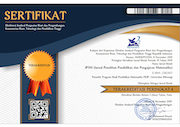Meningkatkan kemampuan koneksi matematik mahasiswa melalui model pembelajaran CORE
Abstract
The issue examined in this study was about the low learning outcomes. The focus of the study discussed was the factors that influenced the learning outcomes, which was the learning model. The learning model chosen was the CORE learning model. The purpose of this study was to invetigate the problem of students' achievement of mathematical connection ability between the learning of using the CORE approach and ordinary learning. This study was a quasi-experimental study with a test design of posttest only control group design. Sampling in this study was using simple random sampling. This was done because the sample members were chosen in proportion. This research was conducted to the students of one of the universities in Karawang. The data collection method was a test, the test instrument was included a mathematical connection ability test. Indicators and variables measured in this study were the level of mathematical connection ability which included the posttest value of the mathematical connection ability test. The data were collected then analyzed using descriptive statistical analysis and inferencial statistics (t-test). Based on data analysis, the achievement of mathematical connection abilities of the students who studied using CORE learning were better than those who studied using expository learning. The achievement of students' mathematical connection skills in the class who studied using the CORE approach was categorized as high while those in the class who studied using expository learning were categorized as medium. Thus, it can be concluded that there are significant differences in student learning outcomes between the learning using CORE approach and using expository learning.
Â
Full Text:
PDFReferences
Azizah, dkk. (2012). Pengembangan Perangkat Pembelajaran Model CORE Bernuansa Konstruktivitis Untuk Meningkatkan Kemampuan Koneksi Matematis. Unnes Journal of Mathematics Education Research. Universitas Negeri Semarang.
Dimiyati, Mudjiono. (2006). Belajar dan Pembelajaran. Jakarta: PT. Rineka Cipta.
Echolls, John M. Dan Hassan Shadily. (1976). Kamus Inggris-Indonesia. Jakarta: Gramedia Pustaka Utama.
Farrell, J. (2009). “Active Learning: Theories and Researchâ€. The Lookstein Center for Jewish Education. Vol. 40 No. 6.
Jihad, Asep., & Haris, Abdul. (2008). Evaluasi Pembelajaran. Yogyakarta: Multi Presindo.
Rohmah, M. S. (2013). Pendekatan Brainstorming Teknik Round-Robin untuk Meningkatkan Kemampuan Penalaran, Komunikasi Matematis dan Self-Awarenes Siswa SMP. Tesis. Sekolah Pascasarjana UPI. Bandung: Tidak diterbitkan
Sardiman. (2011). Interaksi dan Motivasi Belajar Mengajar. Jakarta: PT, Rajagrafindo.
Siddiq, M. Djauhar, dkk.( 2008). Pengembangan bahan ajar SD. Jakarta: Depdiknas.
Sudjana, Nana. (2005). Penilaian hasil proses belajar mengajar. Bandung:PT. Remaja Rosdikarya.
Sumarmo, U. (2003). Pengembangan Berpikir Matematik Tingkat Tinggi pada Siswa SLTP dan SMU serta Mahasiswa Strata Satu (S1) melalui berbagai Pendekatan Pembelajaran. Bandung, Laporan Penelitian Pascasarjana UPI. Bandung : Tidak dipublikasikan.
Suyatno (2009). Menjelajah Pembelajaran Inofatif.(Sidoarjo:Masmedia Buana Pusaka)
DOI: https://doi.org/10.37058/jp3m.v5i1.645
Refbacks
- There are currently no refbacks.
©2017 JP3M (Jurnal Penelitian Pendidikan dan Pengajaran Matematika)
Program Studi Pendidikan Matematika
Fakultas Keguruan dan Ilmu PendidikanÂ
Universitas Siliwangi
Jl. Siliwangi No. 24 Kota Tasikmalaya - 46115
email: jp3m@unsil.ac.id
e-ISSN: 2581-2807 ; p-ISSN: 2460-8599

This work is licensed under a Creative Commons Attribution-NonCommercial-ShareAlike 4.0 International License.
StatCounter:
Detail


